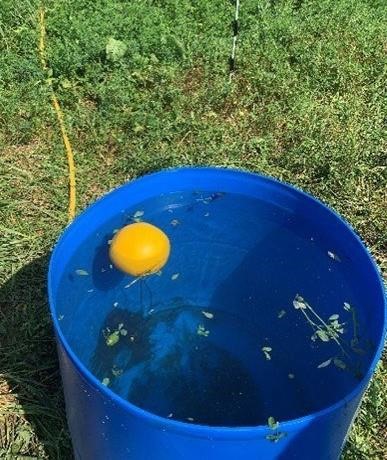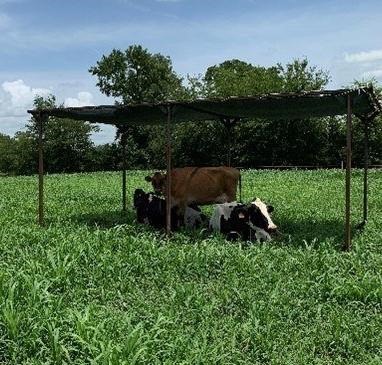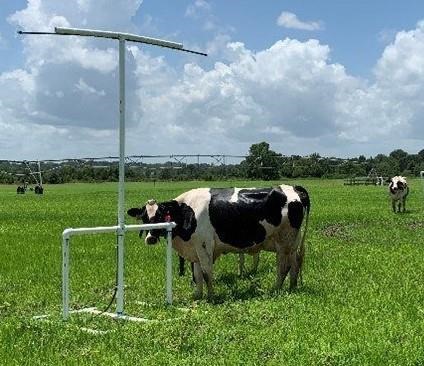By Carly Becker
The negative impacts that heat stress has on lactating dairy cattle has been well researched. If not properly cooled, dairy cattle can have decreased milk production and milk components, decreased fertility leading to an increased number of breeding services per head and longer calving intervals, and decreased immunity contributing to an increased number of cows and heifers that may need to be treated for illnesses. All these negative effects contribute to huge economic losses for farmers and the dairy industry. If the subject of heat stress has been so well studied and discussed at industry meetings and conferences, then why are we still seeing severe drops in cow performance in the summer months and even well into the fall months? In general, lactating dairy cattle begin experiencing heat stress at 68°F, however, this threshold may change depending on humidity, production level of the cow, lactation number, stocking density, dry matter intake, and past health history. High producing dairy cattle may begin experiencing heat stress at just 65°F. Cooling cows before you start seeing signs of heat stress (open mouth breathing, open mouth breathing with tongue out, respiration rate greater than 60 breaths/min) is imperative to reduce the negative effects heat stress on cow performance.
We always hear about cooling lactating cows, but what about dry cows and heifers? The dry period typically consists of 45 to 60 days where a dairy cow is not lactating and is expending her energy towards regenerating the mammary gland, maintaining body condition, and growing the calf. In one study, comparing cows that were cooled during the dry period, heat stressed dry cows had decreased milk production by 6.6 to 16.5 lbs./day and an increased number of health issues in the upcoming lactation (Tao and Dahl, 2013). This leads to a loss of income from lower milk production and increased expenses stemming from more vet calls and treatments. Dry cows are in their late gestation period meaning this is an important time for fetal growth and development. During late gestation, the fetus gains 60% of its birth weight (Bauman and Currie, 1980). So not only can heat stress in the dry period contribute to decreased milk production in the next lactation, but it can also have a long-term impact on the developing calf. The heifer calves of cows that were heat stressed in the dry period produced less milk across multiple lactations and had a lower herd survival rate (Dado-Senn et al., 2020). With increasing costs to raise a heifer from birth to first calving, it is more important than ever for first-calf heifers to come into their first lactation healthy and productive. In addition, keeping cows in the herd for multiple lactations is essential to get a return on investment for the heifers that were raised.
How does heat stress in the dry period affect the prenatal calf?
The developing fetus is unable to control its body temperature independent of the dam, therefore, changes in the dam's core temperature can impact fetal temperature. Heat stressed dry cows will have decreased placental function (Thompson et al., 2013), decreased placental weight (Collier et al., 1982), and decreased placental blood flow (Reynolds et al., 2006), all contributing to a nutrient-restricted environment that restrains fetal growth. On average, calves born to heat-stressed dams weigh 8.8 lbs. less compared to calves born to cows that had access to cooling during the dry period (Dado-Senn et al., 2020). Oftentimes, heat stressed dry cows calve about 4 to 5 days early so this could also be a contributing factor to the decreased calf birth weight. Researchers have reported that in-utero heat stress effects on calf growth can persist for up to one year of age (Tao et al., 2012; Monteiro et al., 2016) potentially leading to delayed first breeding and older age at first calving and ultimately an increased cost to raise that heifer.
Late gestation heat stress can also influence pre-weaned calf metabolism, calf immune response, mammary development, future milk yield, and herd survival rate. Some researchers have found that in-utero heat stressed calves have a decreased feed intake compared to calves whose dams were cooled during the dry period. Additionally, Dado et al. (2020) reported that in-utero heat stressed calves required extra esophageal tube feedings to meet their daily nutritional requirements. Calves born to dams that experienced late gestation heat stress may have a decreased motivation to eat compared to calves whose dams did not experience heat stress in late gestation.
Oftentimes, in-utero heat stressed calves will have a weaker immune system most likely attributed to failed passive transfer of colostrum immunoglobulins. This could occur from a decreased level of immunoglobulin G (IgG) in the dam's colostrum or a decreased ability for the calf to absorb the IgG appropriately (Quigley and Drewry, 1998). Getting good quality colostrum to the calf within an hour of birth is imperative for the future of that heifer but if the calf doesn’t have the ability to absorb the colostrum properly, she is not going to have the immunity in those first couple weeks of life to fight off illnesses.
Mammary development is also affected by in-utero heat stress. Compared to in-utero cooled heifers, in-utero heat stressed calves can have smaller alveoli (the milk ducts inside the udder), decreased number of mammary epithelial cells (milk producing cells), and a lower rate of mammary epithelial cell production (Skibiel et al., 2018). All of this is directly related to decreased milk production for in-utero heat stress heifers in future lactations. As previously mentioned, it is expensive to raise a heifer. In some cases, in-utero heat stressed calves may be culled from the herd before they make it to their first lactation or just after their first lactation, therefore, they are unable to provide a return for the investment that you put into them.
How to Keep Dry Cows and Heifers Cool
Dry cows and heifers need to be provided with cooling mechanisms just like lactating cows. When considering where to house dry cows and heifers on the farm, look for an area that can easily be kept clean and dry and has good ventilation and air exchange. Avoid overstocking the dry cow area to prevent competition for resources. Plenty of fresh, clean water should always be available, even in pasture (3 to 5 inches/head of water space; image 1).

Image 1. Example of a clean drinking water source for heifers on pasture.
If dry cows and heifers have access to pasture, creeks and streams should be fenced off to prevent animals from walking through the water. An appropriate amount of shade for the number of animals on pasture should be available. Whether there are plenty of trees available in each pasture or you provide a portable shade structure (image 2), both are good options to get animals out of the direct sunlight.

Image 2. Example of a homemade portable shade structure for cows and heifers on pasture.
Adding in a portable sprinkler system to a pasture could also be an option for cooling dry cows and heifers (image 3). If dry cows and heifers are housed indoors, providing circulating fans throughout the pen and a sprinkler system along the feed bunk line or in an area that could work for your setup is recommended.

Image 3. Example of a homemade portable sprinkler system to cool cows and heifers on pasture.
By providing dry cows and heifers a clean, comfortable area with appropriate ventilation and cooling and plenty of fresh, clean drinking water can help reduce the negative effects associated with late gestation heat stress. It is important to remember that heifers are the future of your herd, so taking the best care of them starts in the dams’ dry period!
Source : psu.edu